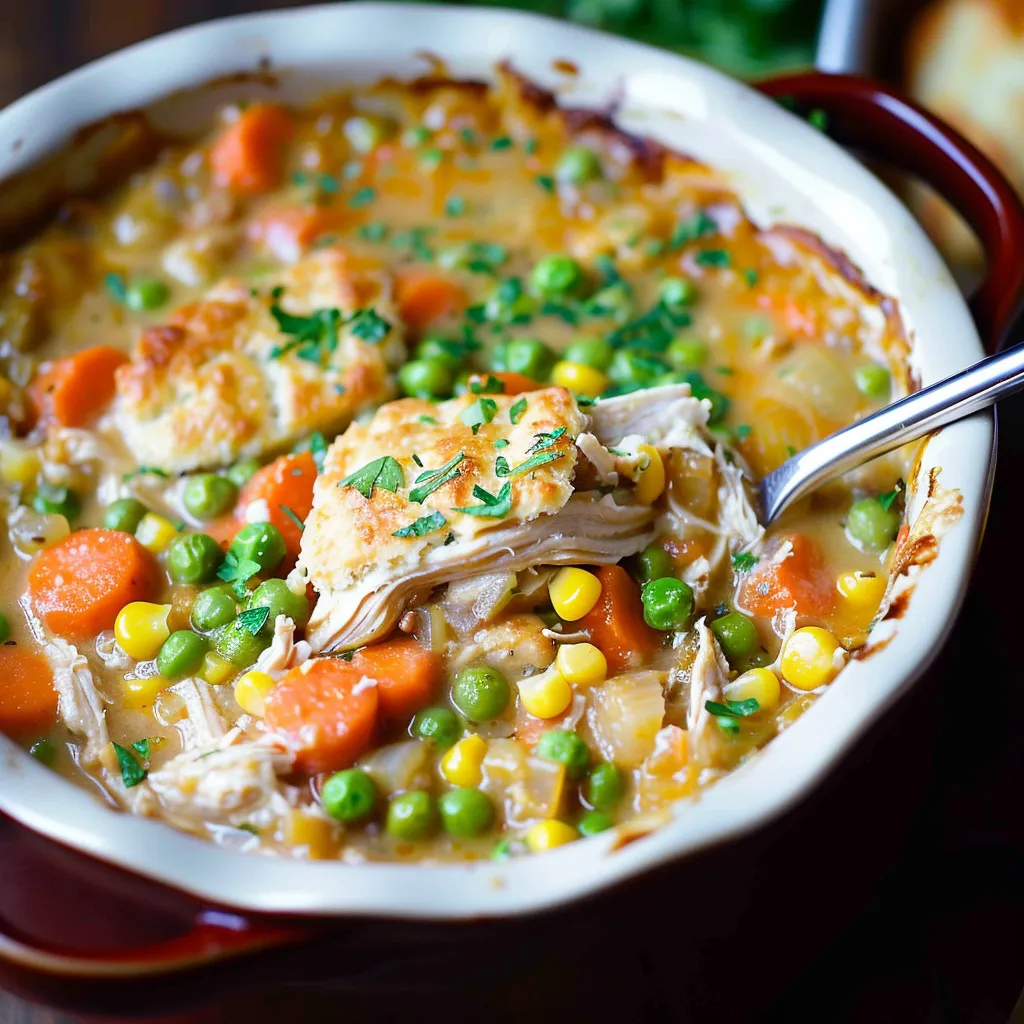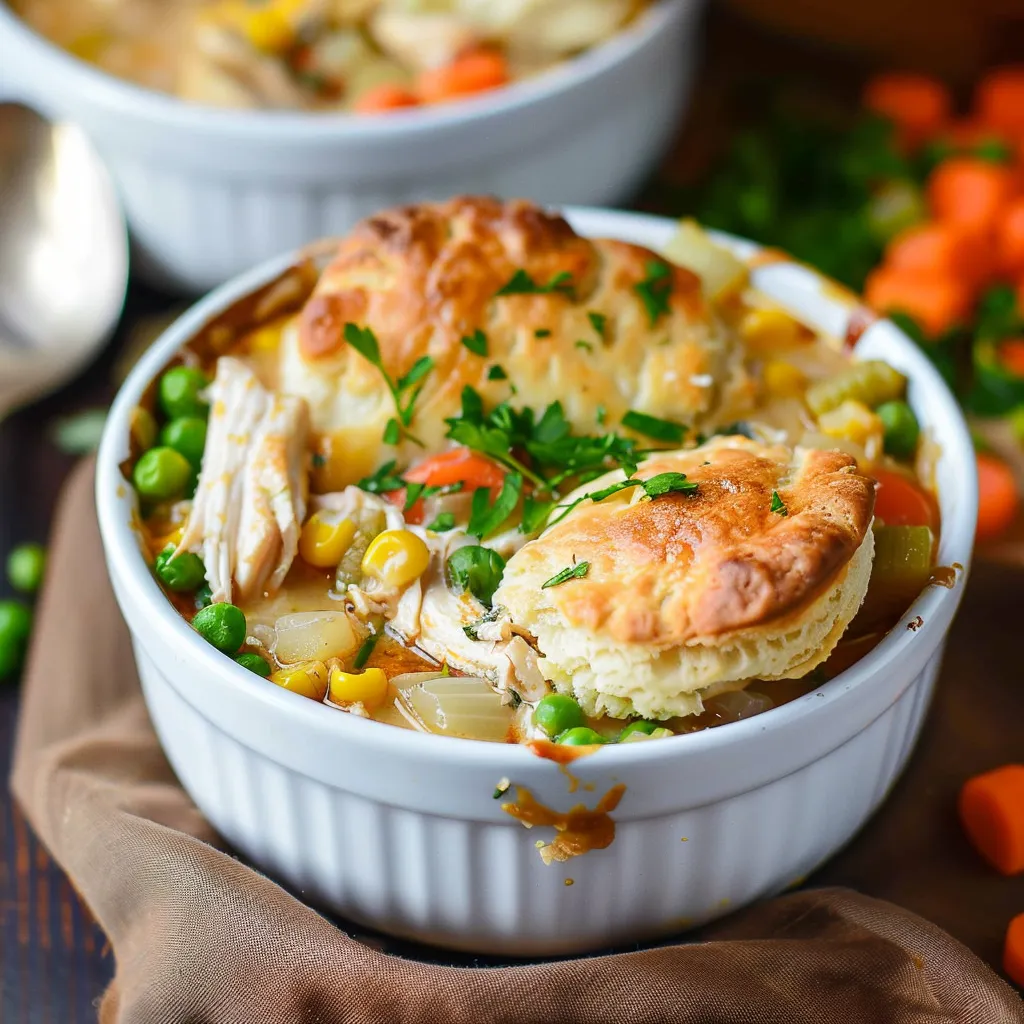 Pin it
Pin it
This snug slow cooker chicken pot pie turns an old-time comfort dish into a no-fuss evening meal. Your slow cooker handles all the work, cooking chicken until it's soft and veggies until they're just right in a thick, dreamy sauce—all finished with a fluffy golden biscuit that gives you that real pot pie feel without the hassle of making pie crust.
I first whipped this up after my third baby arrived and I needed meals that could cook themselves while I juggled baby duties. Now, it's still the meal my family asks for most during those crazy weeks when everyone's rushing in from soccer, dance, or baseball at all hours.
What You'll Need
- Yellow onion: Gives that key background taste that starts it all—grab a medium one for the right flavor punch
- Carrots: Add a touch of sweetness and that classic pot pie taste—pick ones that are crunchy and bright
- Celery: Brings a light garden flavor and nice crunch—look for bright, snappy stalks
- Fresh parsley: Cuts through the richness with fresh taste—the flat Italian kind works great
- Paprika: Adds a slight sweet kick and pretty reddish color
- Dried oregano: Gives a warm, cozy taste that deepens as it cooks
- Kosher salt: Wakes up all the other flavors—Diamond Crystal brand is great if you can find it
- Black pepper: Adds a tiny bit of heat and flavor depth—try grinding it fresh
- Chicken stock: Forms the tasty base—get the low-sodium type so you can adjust salt yourself
- Cream of chicken soup: Makes everything silky smooth without having to stir flour and butter
- Boneless skinless chicken breasts: Cook up tender in the slow cooker—try to get pieces that are about the same size
- Frozen peas: Toss in some green color and sweet bites—we add them near the end so they don't get mushy
- Canned corn: Drops in little bursts of sunshine and sweetness—make sure to drain it well
- Refrigerated biscuits: Give you that classic pot pie top without having to make dough from scratch
How To Make It
- Mix your starter:
- Throw onion, carrots, celery, parsley, paprika, oregano, salt, pepper, chicken stock, and soup into the slow cooker. Stir everything up until it's all mixed together. Don't worry if it looks too thick right now, almost like a paste instead of soup. This thickness is good because the chicken will let out juices as it cooks, thinning things out just right.
- Add your chicken:
- Put your chicken breasts right into the veggie mix, pushing them down so they're partly covered. Take a spoon and scoop some of the mix over the tops of the chicken so it's all coated. This helps the chicken cook evenly and soak up all those good flavors while it cooks.
- Let it cook:
- Put the lid on your slow cooker and set it to low for 8 hours. This long, gentle cooking makes the chicken super tender and lets all the veggies soften up and share their flavors. The slow cooking creates that homey, all-day-in-the-kitchen taste that makes comfort food so good.
- Finish it up:
- About 30 minutes before you're ready to eat, take out the chicken and put it on a cutting board. Grab two forks and pull the chicken apart into bite-sized pieces—it'll come apart really easily. Put the shredded chicken back in the pot and add your peas and drained corn. Give it all a good stir to mix the new veggies in. Let it cook for another 30 minutes so the peas and corn can warm up without getting too soft.
- Top with biscuits:
- While your pot pie filling finishes up, bake your biscuits following the package directions until they're nice and golden. When you're ready to eat, scoop the chicken mixture into bowls and top each one with a hot biscuit. The biscuit will soak up some of the yummy sauce but still stay puffy, giving you that classic pot pie experience.
 Pin it
Pin it
Some folks might think using canned cream of chicken soup is cutting corners, but it actually makes the smoothest, most reliable sauce without standing over the stove stirring flour and butter. My grandma always used it in her pot pie, and that taste takes me straight back to Sunday dinners at her house. Some dishes are special exactly because they stick to tradition rather than trying to be fancy.
Switch Things Up
This dish is super flexible based on what your family likes or what's in your pantry. You can toss in some diced potatoes to make it heartier, just add them at the beginning with the other veggies. If your gang prefers green beans over peas, swap them in. For mushroom lovers, throw in some sliced white mushrooms during the final hour of cooking for a deeper, earthier flavor.
Keeping Leftovers
The filling actually tastes even better the next day as all the flavors get to know each other. Keep any extras in sealed containers in your fridge for up to 3 days. It's best to store the biscuits on their own and warm them up right before you eat the reheated filling. You can also freeze the mixture for up to 3 months—just let it thaw in the fridge overnight before warming it up. When you reheat it, add a splash of chicken stock if it seems too thick.
Lighter Options
Want a healthier version? Try using low-fat or low-sodium cream of chicken soup. You can also make your own creamy base with milk, a bit of flour, and seasonings. Turkey works just as well as chicken with pretty much no difference in how it turns out. You can also pack in more nutrition by adding extra veggies—my kids don't even notice when I double the carrots and sneak in some cauliflower.
 Pin it
Pin it
This is the go-to meal that'll leave your whole family happy, satisfied and asking for seconds!
Frequently Asked Questions
- → Can I swap chicken breasts for thighs?
Absolutely! Thighs add a deeper flavor. Just check they’re fully cooked before serving.
- → How do I make this gluten-free?
Swap in gluten-free cream of chicken soup and biscuits for a totally gluten-free meal.
- → Can I prep it ahead of time?
Yes, you can cut up the veggies and make the sauce the night before. Store them in the fridge and start cooking the next day.
- → What’s a good substitute for cream of chicken soup?
Make a quick mix of butter, flour, chicken stock, and milk to create a creamy homemade alternative.
- → Can I freeze what’s left over?
Sure! Skip freezing the biscuits, though. Store the rest for up to 3 months, thaw in the fridge, and bake fresh biscuits when reheating.
